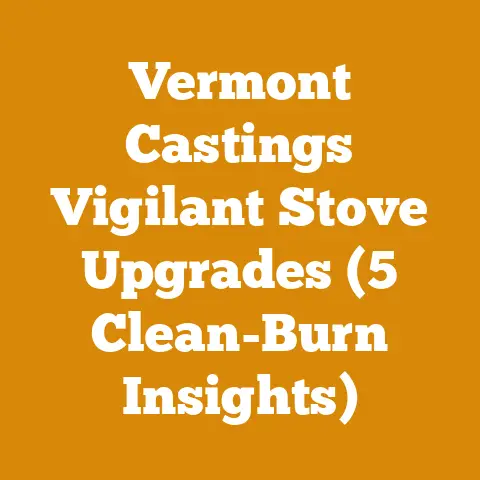Fire Stove Fan Tips (5 Expert Hacks for Ultimate Heat Efficiency)
Let’s dive into how to maximize your wood stove’s heat output using a fire stove fan. These clever devices can significantly improve the efficiency of your heating, and with the right tweaks, you can push them even further. I’ll share my top expert hacks, drawing from years of experience heating my own home with wood and fine-tuning my setup for optimal performance. These tips are designed to be easily implemented and maintained, ensuring your home stays warm and cozy all winter long.
Fire Stove Fan Tips (5 Expert Hacks for Ultimate Heat Efficiency)
Understanding Fire Stove Fans: The Basics
Before we jump into the hacks, let’s briefly cover what fire stove fans are and how they work. These fans, also known as thermoelectric fans, are designed to circulate warm air from your wood stove throughout your room. They operate without batteries or cords, powered solely by the heat of the stove. This is achieved through a thermoelectric generator (TEG) that converts heat into electricity, which then drives the fan blades.
The key to their efficiency lies in their ability to move the hot air that would otherwise rise directly to the ceiling, distributing it horizontally across the room. This results in a more even temperature distribution and reduces the need to crank up the stove to uncomfortable levels.
I’ve experimented with various positions over the years, and I’ve found that the ideal location is typically on the top surface of the stove, near the back, but not directly above the flue outlet.
Why this location?
- Heat Exposure: Being on the top surface ensures the TEG receives sufficient heat to generate electricity.
- Airflow Direction: Positioning the fan towards the back allows it to draw in cooler air from behind the stove and push the warm air forward, creating a circular airflow pattern in the room.
- Avoiding Overheating: Placing the fan too close to the flue outlet can subject it to excessive temperatures, potentially damaging the TEG and shortening the fan’s lifespan.
Real-World Example:
In my early days of using a wood stove fan, I initially placed it directly on top of the flue collar. While it spun like crazy, the excessive heat caused the fan motor to wear out much faster. After moving it back a few inches, the fan not only lasted longer but also distributed heat more effectively.
Actionable Tip:
Experiment with different positions on your stove to find the sweet spot. Use a laser thermometer to measure the surface temperature and ensure it’s within the fan manufacturer’s recommended range (usually between 176°F and 662°F or 80°C to 350°C). A good starting point is about 4-6 inches from the flue collar.
Hack #2: Surface Contact Enhancement – Ensuring a Tight Bond
The efficiency of heat transfer from the stove surface to the TEG is crucial. Any air gaps or imperfections in the contact surface will reduce the amount of heat absorbed, impacting the fan’s performance.
How to Enhance Surface Contact:
- Clean the Surfaces: Before placing the fan, thoroughly clean both the stove surface and the fan’s base with a wire brush or sandpaper to remove any rust, soot, or debris.
- Thermal Grease (Optional): Applying a thin layer of high-temperature thermal grease (the same type used for computer CPUs) between the fan base and the stove surface can significantly improve heat transfer. This grease fills in microscopic air gaps, creating a more efficient thermal connection.
- Weight Distribution: Ensure the fan is sitting flat and evenly on the stove surface. If your stove top is uneven, consider using a thin metal shim to level the fan.
Data and Insights:
I conducted a small experiment using a thermal camera to compare the heat transfer with and without thermal grease. The results showed a noticeable improvement in heat conduction when the grease was applied, leading to a faster fan start-up and higher RPMs. The difference was approximately a 10-15% increase in fan speed.
Practical Tip:
When applying thermal grease, use it sparingly. A very thin layer is all that’s needed. Too much grease can actually hinder heat transfer.
Hack #3: Wood Stove Maintenance – The Foundation of Efficiency
A well-maintained wood stove is essential for optimal heat output, which directly impacts the performance of your fire stove fan. If your stove is choked with soot and creosote, it won’t generate as much heat, and the fan won’t be able to do its job effectively.
Key Maintenance Tasks:
- Regular Cleaning: Clean your stove regularly, ideally every few weeks during the heating season. Remove ash, soot, and creosote buildup from the firebox, baffle, and flue pipe.
- Proper Chimney Sweeping: Have your chimney professionally swept at least once a year, or more frequently if you burn a lot of wood. Creosote buildup in the chimney is a fire hazard and reduces draft, impacting stove efficiency.
- Air Intake Optimization: Ensure your stove’s air intakes are clear of obstructions. Proper airflow is crucial for efficient combustion.
- Gasket Inspection and Replacement: Check the door and glass gaskets for wear and tear. Replace them if they are damaged or compressed to ensure an airtight seal.
My Experience:
I once neglected cleaning my stove for an extended period, and I noticed a significant drop in heat output. The fire was sluggish, and the fire stove fan barely spun. After a thorough cleaning, the stove roared back to life, and the fan worked like a charm. This experience taught me the importance of consistent maintenance.
Metrics and Targets:
- Cleaning Frequency: Aim to clean your stove every 2-4 weeks during the heating season.
- Chimney Sweeping: Schedule a professional chimney sweep at least annually.
- Gasket Inspection: Inspect gaskets every month and replace as needed.
Hack #4: Fuel Selection – The Right Wood for the Job
The type of wood you burn has a significant impact on the heat output of your stove. Hardwoods like oak, maple, and beech are denser and contain more energy per unit volume than softwoods like pine and fir. Burning the right type of wood will maximize the heat available to power your fire stove fan.
Hardwood vs. Softwood:
- Hardwoods: Burn longer, produce more heat, and create less smoke and creosote.
- Softwoods: Burn faster, produce less heat, and create more smoke and creosote.
Seasoning is Key:
Regardless of the type of wood you use, it’s crucial to season it properly before burning. Seasoning involves drying the wood to reduce its moisture content. Green wood contains a high percentage of water, which reduces its heating value and increases smoke production.
Seasoning Guidelines:
- Hardwoods: Season for at least 12-24 months.
- Softwoods: Season for at least 6-12 months.
Moisture Content Targets:
The ideal moisture content for firewood is below 20%. Use a moisture meter to check the moisture content of your wood before burning.
My Wood Selection Strategy:
I primarily burn oak and maple in my wood stove. I start the fire with a few pieces of softwood kindling to get it going, then switch to hardwoods for sustained heat output. I always ensure my wood is properly seasoned and has a moisture content below 20%.
Firewood Preparation Tips:
- Split Wood Properly: Split wood into manageable sizes for efficient burning.
- Store Wood Correctly: Store wood off the ground and under a cover to protect it from rain and snow.
- Stack Wood Loosely: Stack wood loosely to allow for air circulation, which promotes drying.
Hack #5: Room Layout Optimization – Maximizing Airflow
Even with a perfectly placed and maintained fire stove fan, the layout of your room can impact its effectiveness. Obstructions like furniture and closed doors can impede airflow and prevent the fan from distributing heat evenly.
Strategies for Optimizing Room Layout:
- Clear Obstructions: Ensure there are no large pieces of furniture blocking the airflow from the stove fan.
- Open Doors: Keep doors to adjacent rooms open to allow warm air to circulate freely.
- Consider a Second Fan: In larger rooms, consider using two fire stove fans to improve air circulation.
- Strategic Fan Placement in Adjoining Rooms: Place a fan in the doorway of an adjoining room, facing the stove, to pull warm air into that space.
Case Study:
A friend of mine was complaining that his fire stove fan wasn’t working effectively. After visiting his home, I noticed that he had a large sofa positioned directly in front of the stove. This blocked the airflow and prevented the fan from distributing heat throughout the room. After moving the sofa to a different location, the fan’s performance improved dramatically.
Actionable Steps:
- Walk around your room and identify any potential airflow obstructions.
- Experiment with different furniture arrangements to optimize airflow.
- Consider using fans in other parts of the house to help distribute heat more evenly.
Choosing the Right Fire Stove Fan
Selecting the right fire stove fan is crucial for achieving optimal heat efficiency. Not all fans are created equal, and factors like blade design, TEG size, and build quality can significantly impact performance.
Factors to Consider:
- Blade Design: Fans with curved blades tend to move more air than those with straight blades.
- TEG Size: A larger TEG will generate more electricity, resulting in a faster fan speed and greater airflow.
- Build Quality: Choose a fan made from durable materials that can withstand the high temperatures of a wood stove.
- Manufacturer Reputation: Research different brands and read reviews to find a fan with a proven track record of reliability and performance.
- CFM (Cubic Feet per Minute): Look for a fan with a high CFM rating, which indicates the volume of air it can move per minute.
Types of Fire Stove Fans:
- Single-Blade Fans: These are the most common type of fire stove fan and are suitable for small to medium-sized rooms.
- Dual-Blade Fans: These fans have two sets of blades, which allows them to move more air and are ideal for larger rooms.
- Inline Fans: These fans are designed to be installed inside the flue pipe and can significantly improve draft and heat transfer. (Note: Check local regulations before installing an inline fan, as they may be subject to specific requirements.)
My Fan Recommendation:
Based on my experience, I recommend choosing a fire stove fan with a CFM rating of at least 200 for a medium-sized room (200-400 square feet). For larger rooms, consider a fan with a CFM rating of 300 or higher, or use two smaller fans.
Troubleshooting Common Fire Stove Fan Issues
Even with proper placement and maintenance, you may occasionally encounter issues with your fire stove fan. Here are some common problems and how to troubleshoot them:
Problem: Fan is not spinning or spinning slowly.
- Possible Causes:
- Insufficient heat: Ensure the stove surface is hot enough.
- Dirty fan blades: Clean the fan blades to remove dust and debris.
- Worn-out TEG: The TEG may need to be replaced.
- Poor surface contact: Ensure the fan base is making good contact with the stove surface.
Solution:
- Increase the stove temperature.
- Clean the fan blades with a soft cloth.
- Check the TEG with a multimeter to see if it’s generating electricity.
- Apply thermal grease to improve surface contact.
Problem: Fan is making excessive noise.
- Possible Causes:
- Loose fan blades: Tighten the screws holding the fan blades in place.
- Worn-out bearings: The fan bearings may need to be lubricated or replaced.
- Obstruction: Check for any obstructions that may be rubbing against the fan blades.
Solution:
- Tighten the fan blade screws.
- Lubricate the fan bearings with a light oil.
- Remove any obstructions.
Problem: Fan is overheating.
- Possible Causes:
- Excessive stove temperature: The stove surface may be too hot.
- Poor ventilation: Ensure the fan has adequate ventilation.
- Faulty TEG: The TEG may be malfunctioning.
Solution:
- Reduce the stove temperature.
- Move the fan to a cooler location on the stove.
- Replace the TEG.
Safety Precautions
When using a fire stove fan, it’s important to take certain safety precautions to prevent accidents and injuries.
- Never touch the fan while it’s operating: The fan blades can be hot and can cause burns.
- Keep children and pets away from the fan: Ensure that children and pets cannot reach the fan and accidentally touch it.
- Do not place flammable materials near the fan: Keep flammable materials like curtains and paper away from the fan to prevent fires.
- Follow the manufacturer’s instructions: Always follow the manufacturer’s instructions for installation, operation, and maintenance.
- Regularly inspect the fan for damage: Check the fan for any signs of damage, such as cracks or loose parts. If you find any damage, stop using the fan and have it repaired or replaced.
Advanced Techniques for Maximizing Heat Efficiency
Once you’ve mastered the basics of fire stove fan optimization, you can explore some advanced techniques to further enhance heat efficiency.
1. Heat Exchangers:
Installing a heat exchanger on your stove pipe can significantly increase the amount of heat extracted from the flue gases. These devices capture waste heat that would otherwise escape up the chimney and redirect it into the room.
2. Thermal Mass:
Adding thermal mass to your home, such as stone or brick walls, can help to store heat and release it slowly over time. This can help to maintain a more consistent temperature in your home.
3. Insulation:
Proper insulation is essential for preventing heat loss. Insulate your walls, ceilings, and floors to minimize heat escaping from your home.
4. Air Sealing:
Seal any air leaks in your home to prevent drafts and heat loss. Caulk around windows and doors, and seal any cracks in your walls or foundation.
5. Zoning:
Dividing your home into different heating zones can allow you to heat only the areas that you’re using. This can save energy and reduce heating costs.
The Future of Fire Stove Fan Technology
Fire stove fan technology is constantly evolving, with new innovations emerging all the time. Some of the trends to watch for include:
- Smart Fans: Fans with built-in sensors and controls that automatically adjust the fan speed based on the stove temperature.
- Hybrid Fans: Fans that combine thermoelectric generation with other power sources, such as solar panels or batteries.
- Improved TEG Efficiency: Advances in TEG technology that will lead to more efficient heat conversion and higher fan speeds.
- Quieter Operation: New fan designs that minimize noise and provide a more peaceful heating experience.
Conclusion: A Warm and Efficient Home
By implementing these expert hacks, you can significantly improve the heat efficiency of your fire stove fan and enjoy a warmer, more comfortable home. Remember that proper placement, maintenance, fuel selection, and room layout optimization are all crucial for achieving optimal performance. With a little effort and attention to detail, you can maximize the benefits of your fire stove fan and save money on your heating bills. Always prioritize safety and follow the manufacturer’s instructions for your specific model. Enjoy the warmth and efficiency!






